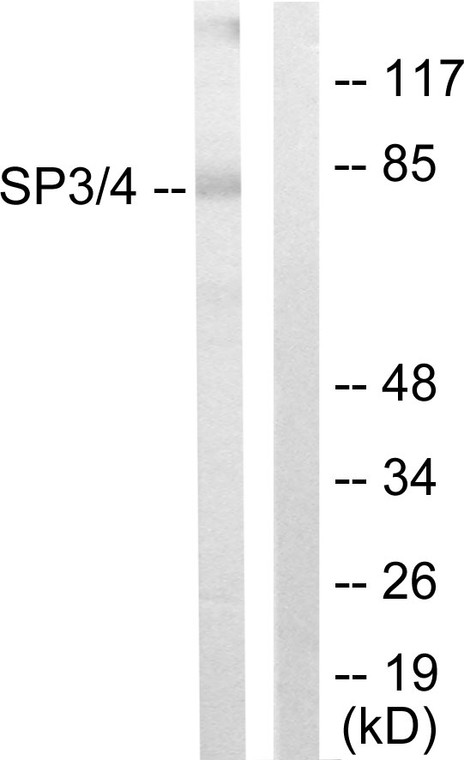| Host: |
Rabbit |
| Applications: |
WB/IHC/IF/ELISA |
| Reactivity: |
Human/Mouse/Rat |
| Note: |
STRICTLY FOR FURTHER SCIENTIFIC RESEARCH USE ONLY (RUO). MUST NOT TO BE USED IN DIAGNOSTIC OR THERAPEUTIC APPLICATIONS. |
| Short Description: |
Rabbit polyclonal antibody anti-Transcription factor Sp3 and Transcription factor Sp4 (671-720 aa) is suitable for use in Western Blot, Immunohistochemistry, Immunofluorescence and ELISA research applications. |
| Clonality: |
Polyclonal |
| Conjugation: |
Unconjugated |
| Isotype: |
IgG |
| Formulation: |
Liquid in PBS containing 50% Glycerol, 0.5% BSA and 0.02% Sodium Azide. |
| Purification: |
The antibody was affinity-purified from rabbit antiserum by affinity-chromatography using epitope-specific immunogen. |
| Concentration: |
1 mg/mL |
| Dilution Range: |
WB 1:500-1:2000IHC 1:100-1:300IF 1:200-1:1000ELISA 1:10000 |
| Storage Instruction: |
Store at-20°C for up to 1 year from the date of receipt, and avoid repeat freeze-thaw cycles. |
| Gene Symbol: |
SP4SP3 |
| Gene ID: |
66716670 |
| Uniprot ID: |
SP4_HUMANSP3_HUMAN |
| Immunogen Region: |
671-720 aa |
| Specificity: |
Sp3/4 Polyclonal Antibody detects endogenous levels of Sp3/4 protein. |
| Immunogen: |
The antiserum was produced against synthesized peptide derived from the human SP3/4 at the amino acid range 671-720 |
| Post Translational Modifications | Not glycosylated. Acetylated by histone acetyltransferase p300, deacetylated by HDACs. Acetylation/deacetylation states regulate transcriptional activity. Acetylation appears to activate transcription. Alternate sumoylation and acetylation at Lys-551 also control transcriptional activity. Ceramides can also regulate acetylation/deacetylation events through altering the interaction of HDAC with SP3. In vitro, C(18)-ceramides, but not C(16)-ceramides, increase the interaction of HDAC1 with SP3 and enhance the deacetylation of SP3 and the subsequent repression of the TERT promoter. Sumoylated on all isoforms. Sumoylated on 2 sites in longer isoforms with Lys-551 being the major site. Sumoylation at this site promotes nuclear localization to the nuclear periphery, nuclear dots and PML nuclear bodies. Sumoylation on Lys-551 represses the transactivation activity, except for the largest isoform, L-Sp3, which has little effect on transactivation. Alternate sumoylation and acetylation at Lys-551 also control transcriptional activity. |
| Function | Transcriptional factor that can act as an activator or repressor depending on isoform and/or post-translational modifications. Binds to GT and GC boxes promoter elements. Competes with SP1 for the GC-box promoters. Weak activator of transcription but can activate a number of genes involved in different processes such as cell-cycle regulation, hormone-induction and house-keeping. |
| Protein Name | Transcription Factor Sp3Spr-2 |
| Database Links | Reactome: R-HSA-3232118 |
| Cellular Localisation | NucleusPml BodyLocalizes To The Nuclear Periphery And In Nuclear Dots When SumoylatedSome Localization In Pml Nuclear Bodies |
| Alternative Antibody Names | Anti-Transcription Factor Sp3 antibodyAnti-Spr-2 antibodyAnti-SP3 antibody |
Information sourced from Uniprot.org
12 months for antibodies. 6 months for ELISA Kits. Please see website T&Cs for further guidance







